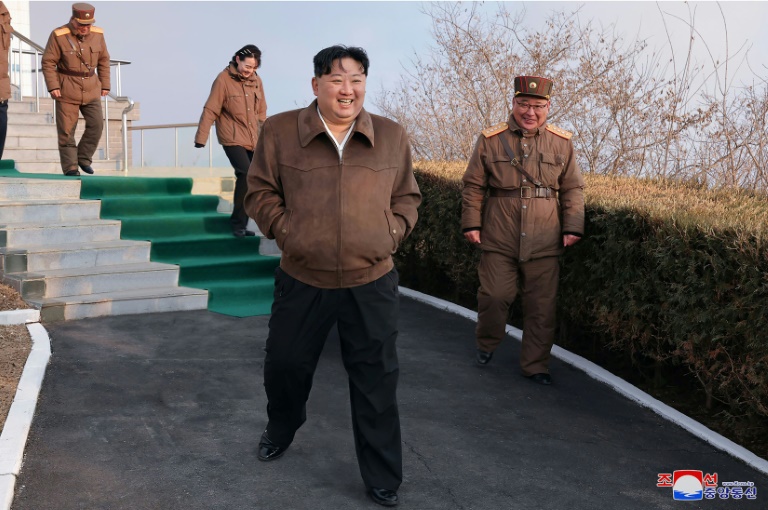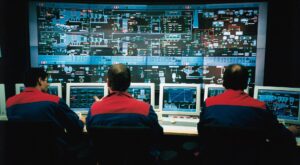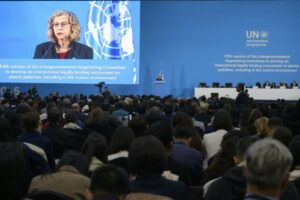N. Korea’s Kim oversees hypersonic missile engine test: state media

The test was carried out on Tuesday by the North’s Missile Administration at the Sohae Satellite Launching Ground in the northwest of the country – Copyright AFP SEYLLOU
North Korean leader Kim Jong Un oversaw a successful test of a solid-fuel engine for a “new-type intermediate-range hypersonic missile”, Pyongyang’s state media said Wednesday.
The test was carried out on Tuesday by the North’s Missile Administration at the Sohae Satellite Launching Ground in the northwest of the country, according to the official Korean Central News Agency (KCNA).
“A ground jet test of a solid-fuel engine for new-type intermediate-range hypersonic missile, which is of another strategic value,” KCNA said.
The North Korean leader said the “military strategic value of this weapon system is appreciated as important as ICBM”, it added, referring to an intercontinental ballistic missile.
Kim also said that the test had helped “confirm the timetable for completing” the new missile system, without giving further details.
Pyongyang said late last year that it had conducted a series of ground tests for a new type of solid-fuel engine for its intermediate-range ballistic missiles (IRBMs).
– ‘Quite alarming’ –
North Korea’s latest announcement came a day after North Korea said Kim oversaw drills involving “newly-equipped super-large” multiple rocket launchers, with emphasis on “perfect preparedness to collapse the capital of the enemy”.
Hypersonic missiles travel at speeds of at least Mach 5 — five times the speed of sound — and can manoeuvre mid-flight, making them harder to track and intercept.
Depending on their design, they can carry both conventional and nuclear warheads.
Russia, which has recently bolstered its ties with Pyongyang, is typically seen as the world leader in this technology, although the US and China have also tested hypersonic missiles.
North Korea appears to be leveraging its stronger ties with Russia to expedite crucial defence development goals, Yang Moo-jin, president of the University of North Korean Studies in Seoul, told AFP.
“It is quite alarming as the (solid-fuel hypersonic missiles) can potentially neutralise the South Korea-US missile defense system,” Yang said.
Testing a more technologically advanced solid-fuel missile has long been a key goal for Kim.
The North claimed last year it had successfully tested its first solid-fuelled ICBM — the largest, longest-range category of ballistic missile — hailing it as a key breakthrough for the country’s nuclear counterattack capabilities.
Experts say solid-fuel missiles typically have a higher level of operational ease and safety, compared to liquid-fuel weapons.
Solid-fuel missiles do not need to be fuelled before launch, making them harder to find and destroy, as well as quicker to use.
“How this latest ground test relates to the system(s) tested in November and January is unconfirmed,” Joseph Dempsey, a research associate for defence analysis at the International Institute for Strategic Studies, told AFP.
– ‘Dear price’ –
The United States and South Korea wrapped up one of their major annual joint military exercises last week, prompting angry retorts and live-fire drills from nuclear-armed Pyongyang, which condemns all such exercises as rehearsals for invasion.
North Korea this month warned that Seoul and Washington would pay a “dear price” over their military exercises, and later announced that Kim had guided an artillery unit it says was capable of striking the South Korean capital.
Kim last week also oversaw paratrooper drills aimed at showing his soldiers’ ability to occupy an “enemy region at a stroke”, according to state media.
Monday’s ballistic missile test was the North’s second this year, after Pyongyang launched one tipped with a manoeuvrable hypersonic warhead on January 14.
So far this year, the nuclear-armed North has declared South Korea its “principal enemy”, jettisoned agencies dedicated to reunification and outreach, and threatened war over “even 0.001 mm” of territorial infringement.
Seoul is one of Washington’s key regional allies, and the United States has stationed about 27,000 American soldiers in the South to help protect it against Pyongyang.
Last week’s Washington-Seoul drills included “clearing operations” inside North Korea’s “key facilities” in case of an attack by Pyongyang, according to Seoul’s military.
N. Korea’s Kim oversees hypersonic missile engine test: state media
#Koreas #Kim #oversees #hypersonic #missile #engine #test #state #media





